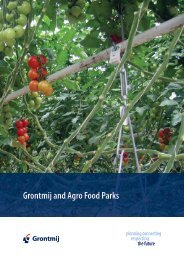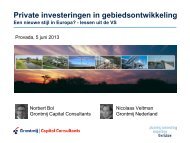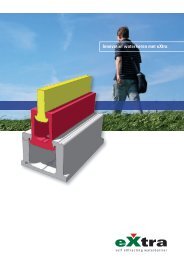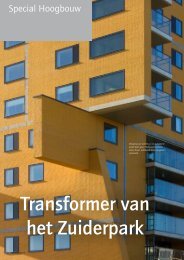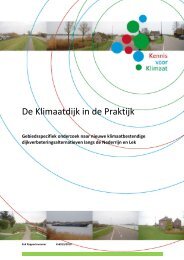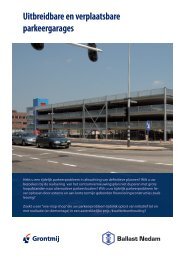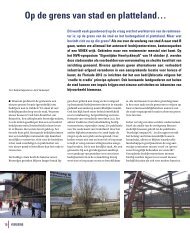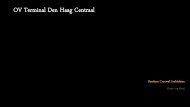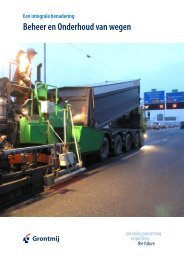Evaluation of draught in surgical operating theatres ... - Emerald
Evaluation of draught in surgical operating theatres ... - Emerald
Evaluation of draught in surgical operating theatres ... - Emerald
Create successful ePaper yourself
Turn your PDF publications into a flip-book with our unique Google optimized e-Paper software.
The current issue and full text archive <strong>of</strong> this journal is available at<br />
www.emerald<strong>in</strong>sight.com/1472-5967.htm<br />
JFM<br />
9,1<br />
64<br />
Received April 2010<br />
Accepted May 2010<br />
PRACTICE BRIEFING<br />
<strong>Evaluation</strong> <strong>of</strong> <strong>draught</strong> <strong>in</strong> <strong>surgical</strong><br />
operat<strong>in</strong>g <strong>theatres</strong>: proposed<br />
revision to (NEN)-EN-ISO-7730<br />
Paul Roel<strong>of</strong>sen<br />
Grontmij/Technical Management, Amersfoort, The Netherlands<br />
Abstract<br />
Purpose – The purpose <strong>of</strong> this paper is to show that it is advisable to evaluate <strong>draught</strong> <strong>in</strong> an operat<strong>in</strong>g<br />
theatre <strong>in</strong> a different manner than the method accord<strong>in</strong>g to NEN-EN-ISO-7730. The NEN-EN-ISO-7730 is<br />
an <strong>in</strong>ternational standard for the analytical determ<strong>in</strong>ation and <strong>in</strong>terpretation <strong>of</strong> the thermal comfort <strong>of</strong><br />
the human body and the local thermal comfort like for <strong>in</strong>stance <strong>draught</strong>.<br />
Design/methodology/approach – Us<strong>in</strong>g a CFD computer program, it is possible to evaluate<br />
<strong>draught</strong> <strong>in</strong> an operat<strong>in</strong>g theatre <strong>in</strong> the design stage, accord<strong>in</strong>g to different mathematical <strong>draught</strong> models.<br />
F<strong>in</strong>d<strong>in</strong>gs – It would seem advisable to beg<strong>in</strong> with the <strong>draught</strong> model developed by Griefahn.<br />
The model does, however, need to be modified to <strong>in</strong>clude the effects <strong>of</strong> temperature sensation and the<br />
direction <strong>of</strong> the air stream, so that it becomes applicable to a thermally cool environment (PMV , 0) and<br />
a vertical air stream, the air pattern prescribed for an operat<strong>in</strong>g theatre.<br />
Orig<strong>in</strong>ality/value – It can be demonstrated that by implement<strong>in</strong>g the proposal <strong>in</strong> this paper <strong>in</strong> a CFD<br />
program, the possibility exists to be able to evaluate, <strong>in</strong> a responsible fashion, the results for a much<br />
broader range <strong>of</strong> parameters than is currently possible by means <strong>of</strong> the NEN-EN-ISO-7730.<br />
Keywords Operat<strong>in</strong>g <strong>theatres</strong>, Temperature, Air, International standards<br />
Paper type Research paper<br />
Journal <strong>of</strong> Facilities Management<br />
Vol. 9 No. 1, 2011<br />
pp. 64-70<br />
q <strong>Emerald</strong> Group Publish<strong>in</strong>g Limited<br />
1472-5967<br />
DOI 10.1108/14725961111105736<br />
Introduction<br />
In The Netherlands, almost all <strong>surgical</strong> operat<strong>in</strong>g <strong>theatres</strong> are provided with a supply air<br />
plenum hav<strong>in</strong>g dimensions <strong>of</strong> 1.2 £ 2.4 meter. The application <strong>of</strong> such a plenum is<br />
extremely important <strong>in</strong> order to ensure that filtered clean air flows from the whole plenum<br />
area vertically downwards over the open <strong>in</strong>cision <strong>of</strong> the patient and, to a certa<strong>in</strong> extent,<br />
also over the operat<strong>in</strong>g team and tables upon which the <strong>surgical</strong> <strong>in</strong>struments are laid out.<br />
Nowadays, due to new <strong>in</strong>sights <strong>in</strong>to <strong>in</strong>fection prevention, the air distribution with<strong>in</strong><br />
an operat<strong>in</strong>g theatre proposes to use a much larger supply air plenum <strong>of</strong> 3.5 £ 3.5 meter<br />
together with a proportionally larger supply air quantity. In this manner, the operat<strong>in</strong>g<br />
table, the operat<strong>in</strong>g team and the <strong>surgical</strong> <strong>in</strong>strument tables are fully enveloped by the<br />
clean, filtered air from the ceil<strong>in</strong>g. As a consequence, the surround<strong>in</strong>gs and adjacent<br />
rooms become less critical objects s<strong>in</strong>ce the chances <strong>of</strong> bacterial contam<strong>in</strong>ation are<br />
significantly reduced.<br />
Such developments, therefore, not only have an impact on the technical <strong>in</strong>stallations but<br />
also on the layouts <strong>of</strong> the <strong>surgical</strong> departments (College bouw ziekenhuisvoorzien<strong>in</strong>gen,<br />
2003).<br />
Ow<strong>in</strong>g to the larger plenum and supply air volume, the members <strong>of</strong> the <strong>surgical</strong> team<br />
would now be “washed over” with cooled air, and as a consequence <strong>of</strong> the differ<strong>in</strong>g
activity levels and cloth<strong>in</strong>g, it is appropriate to consider any effects <strong>of</strong> unwelcome<br />
<strong>draught</strong>s which may occur.<br />
Draught<br />
Draught is def<strong>in</strong>ed as an unwelcome cool<strong>in</strong>g <strong>of</strong> a part <strong>of</strong> the human body as a result <strong>of</strong><br />
air movement.<br />
Draught, conform<strong>in</strong>g to NEN-EN-ISO 7730<br />
Currently, it is conventional to determ<strong>in</strong>e the effects <strong>of</strong> comfort, caused by <strong>draught</strong>,<br />
through the use <strong>of</strong> a mathematical sk<strong>in</strong> model, whereby the percentage <strong>of</strong> compla<strong>in</strong>ants<br />
can be calculated and predicted us<strong>in</strong>g the parameters <strong>of</strong> air temperature, the average air<br />
speed and air turbulence <strong>in</strong>tensity, <strong>in</strong> accordance with NEN-EN-ISO 7730 (2005)<br />
(Figure 1). The NEN-EN-ISO-7730 is an <strong>in</strong>ternational standard for the analytical<br />
determ<strong>in</strong>ation and <strong>in</strong>terpretation <strong>of</strong> the thermal comfort <strong>of</strong> the human body and the local<br />
thermal comfort like for <strong>in</strong>stance <strong>draught</strong>.<br />
This <strong>draught</strong> model was based upon a study <strong>of</strong> 150 test persons, <strong>in</strong> an air temperature<br />
between 208Cand268C, an average (horizontal) air speed <strong>of</strong> between 0.1 and 0.4 m/s and<br />
a turbulence <strong>in</strong>tensity between 10 and 70 per cent. The model is specifically applicable to<br />
occupants with a low activity level, i.e. <strong>in</strong> the ma<strong>in</strong> seated (metabolism
JFM<br />
9,1<br />
66<br />
The application <strong>of</strong> the aforementioned comfort <strong>draught</strong> model would not appear to be<br />
appropriate for evaluat<strong>in</strong>g discomfort due to <strong>draught</strong>s <strong>in</strong> an operat<strong>in</strong>g theatre.<br />
The follow<strong>in</strong>g parameters used <strong>in</strong> the comfort model, therefore, cannot be applied<br />
and need to be re-assessed:<br />
.<br />
the metabolic rate and the activity;<br />
.<br />
the temperature sensation (m.n. PMV , 0); and<br />
.<br />
the direction <strong>of</strong> airflow.<br />
Influences <strong>of</strong> metabolism and activity upon the sensation <strong>of</strong> <strong>draught</strong><br />
Studies carried out by T<strong>of</strong>tum (1994) (Figure 2) and Griefahn (1999) (Figure 3) give an<br />
<strong>in</strong>dication as to how far the metabolism and externally transmitted activity heat<br />
<strong>in</strong>fluences <strong>draught</strong>.<br />
The <strong>draught</strong> models <strong>of</strong> T<strong>of</strong>tum and Griefahn are based upon the <strong>draught</strong> model<br />
conform<strong>in</strong>g to NEN-EN-ISO-7730.<br />
In Table I, a comparison is shown between the applicable parameter ranges for the<br />
various <strong>draught</strong> models.<br />
From Table I, it would appear that the <strong>draught</strong> model formulated by Griefahn has<br />
the largest applicable parameter range. The Griefahn experiments show that the model<br />
which had been developed by them had the largest correlation with the experimental<br />
results. Discomfort, due to <strong>draught</strong>, formulated by Griefahn, may be calculated us<strong>in</strong>g<br />
the follow<strong>in</strong>g formula:<br />
Draught rat<strong>in</strong>g (%)<br />
25.00000<br />
23.43750<br />
21.87500<br />
20.31250<br />
18.75000<br />
17.18750<br />
15.62500<br />
14.06250<br />
12.50000<br />
10.93750<br />
9.375000<br />
7.812500<br />
6.250000<br />
4.687500<br />
3.125000<br />
1.562500<br />
0.000000<br />
Probe value<br />
2.017788<br />
Average value<br />
5.177231<br />
Figure 2.<br />
Conforms to T<strong>of</strong>tum<br />
(1994)<br />
FLAIR<br />
OPERATING THEATRE
Draught rat<strong>in</strong>g (%)<br />
25.00000<br />
23.43750<br />
21.87500<br />
20.31250<br />
18.75000<br />
17.18750<br />
15.62500<br />
14.06250<br />
12.50000<br />
10.93750<br />
9.375000<br />
7.812500<br />
6.250000<br />
4.687500<br />
3.125000<br />
1.562500<br />
0.000000<br />
Probe value<br />
3.714398<br />
Average value<br />
9.530385<br />
Surgical<br />
operat<strong>in</strong>g<br />
<strong>theatres</strong><br />
67<br />
FLAIR<br />
OPERATING THEATRE<br />
Figure 3.<br />
Conforms to Griefahn<br />
(1999)<br />
Draught model<br />
Metabolism<br />
(W/m 2 )<br />
Air temperature<br />
(8C)<br />
Average air speed<br />
(m/s)<br />
Turbulance <strong>in</strong>tensity<br />
(%)<br />
NEN-EN-ISO-7730 (2005) < 70 20-26 0.1-0.4 10-70<br />
T<strong>of</strong>tum (1994) 104-129 11-20 0.1-0.4 10-40<br />
Griefahn (1999) < 60-156 11-23 0.1-0.4 20-90<br />
Table I.<br />
Applicable ranges for<br />
the <strong>draught</strong> models<br />
PD ¼ðtsk 2 taÞ ·ðva 2 0:05Þ 0:623 ·ð3:143 þ 0:37 ·va·TuÞ·ð1 2 0:0061 ·ðM 2 W 2 70ÞÞ<br />
where<br />
PD ¼ the percentage dissatisfaction as a result <strong>of</strong> <strong>draught</strong> (per cent);<br />
t sk<br />
t a<br />
v a<br />
Tu<br />
M<br />
¼ 32.3 þ 0.079 * t a 2 0.019 * (M 2 W) (8C);<br />
¼ the air temperature (8C);<br />
¼ the average air speed (m/s);<br />
¼ the turbulence <strong>in</strong>tensity (per cent);<br />
¼ metabolic rate (W/m 2 ); and<br />
W ¼ externally transmitted, activity related, heat rate (W/m 2 ).
JFM<br />
9,1<br />
68<br />
Influence <strong>of</strong> temperature upon sensitivity to <strong>draught</strong><br />
Another study carried out by T<strong>of</strong>tum and Nielsen (1996) showed that the sensation <strong>of</strong><br />
cooler/colder temperatures (PMV , 0) significantly <strong>in</strong>creases discomfort.<br />
Consequently, the percentage dissatisfaction, as a result <strong>of</strong> the sensation <strong>of</strong> <strong>draught</strong>,<br />
was greater as a result <strong>of</strong> cooler/colder temperatures than by neutral (PMV < 0)<br />
temperature. This also seems to expla<strong>in</strong> why persons, active <strong>in</strong> a cooler environment,<br />
compla<strong>in</strong> <strong>of</strong> <strong>draught</strong> even when the average air speed is lower.<br />
The <strong>in</strong>fluence <strong>of</strong> the temperature sensation upon discomfort, as a result <strong>of</strong> <strong>draught</strong>,<br />
is calculated by the follow<strong>in</strong>g formula presented by T<strong>of</strong>tum:<br />
PD cool<br />
100<br />
¼<br />
PD neutral ð1 þ expð2b:TMV cool 2 lnðPD neutral =ð100 2 PD neutral ÞÞÞ :PD neutralÞ<br />
where<br />
PD neutral ¼ percentage dissatisfaction as a result <strong>of</strong> <strong>draught</strong> with a neutral<br />
temperature sensation (PMV < 0) (per cent);<br />
PD cool<br />
ß<br />
¼ percentage dissatisfaction as a result <strong>of</strong> <strong>draught</strong> <strong>in</strong> a cooler environment<br />
(per cent);<br />
¼ regression coefficient: 20.829 (2); and<br />
TMV ¼ temperature sensation <strong>in</strong> a cool environment (PMV , 0) (2).<br />
Influence <strong>of</strong> air flow direction upon <strong>draught</strong><br />
All the previously mentioned <strong>draught</strong> models are based upon a horizontal air stream.<br />
Other studies (Zhou, 2004; Mayer and Schwab, 1990) <strong>in</strong>dicate that the air stream<br />
direction has a dramatic effect upon the feel<strong>in</strong>g <strong>of</strong> <strong>draught</strong> discomfort. Occupants<br />
subject to an airflow <strong>in</strong> a downward direction appear to be less conscious <strong>of</strong> <strong>draught</strong>s<br />
than when <strong>in</strong> a horizontal air stream.<br />
The <strong>in</strong>fluence <strong>of</strong> the flow direction upon discomfort as a result <strong>of</strong> <strong>draught</strong> is<br />
expressed <strong>in</strong> the follow<strong>in</strong>g formula, developed by Genhon Zhou, below:<br />
PD flow direction<br />
PD neutral<br />
¼ expðd:ðta 2 24ÞÞ ½2Š<br />
where<br />
PD flowdirection<br />
d<br />
t a<br />
¼ percentage dissatisfaction as a result <strong>of</strong> flow direction (per cent);<br />
¼ coefficient, conform<strong>in</strong>g to Table II (2); and<br />
¼ air temperature (8C).<br />
Table II.<br />
Coefficient (d) dependent<br />
upon the flow direction<br />
Flow direction<br />
d<br />
Vertically downwards 0.12<br />
Horizontal 0<br />
Vertically upwards 20.05
Calculation results<br />
To give an idea <strong>of</strong> how the calculated results differ from each other and with the aid <strong>of</strong><br />
a CFD computer program, the percentage dissatisfaction has been calculated for each<br />
model <strong>in</strong> an operat<strong>in</strong>g theatre with a supply air plenum <strong>of</strong> 3.5 £ 3.5 m.<br />
The follow<strong>in</strong>g parameters, for a surgeon (Melhado et al., 2005), have been used:<br />
.<br />
Metabolism: 128 W/m 2 .<br />
.<br />
Mechanical efficiency: 0.086 (2).<br />
.<br />
Intr<strong>in</strong>sic cloth<strong>in</strong>g resistance: 0.95 clo.<br />
Surgical<br />
operat<strong>in</strong>g<br />
<strong>theatres</strong><br />
69<br />
Conclusion and advice<br />
It is evident that the <strong>draught</strong> model conform<strong>in</strong>g to NEN-EN-ISO-7730 is not applicable<br />
for evaluat<strong>in</strong>g <strong>draught</strong>s <strong>in</strong> an operat<strong>in</strong>g theatre or <strong>in</strong> any other situations where<br />
occupants are not perform<strong>in</strong>g a calmly sitt<strong>in</strong>g activity (M
JFM<br />
9,1<br />
70<br />
Advice<br />
.<br />
To further <strong>in</strong>vestigate <strong>in</strong> how far the <strong>in</strong>fluence <strong>of</strong> the air direction, <strong>of</strong> which the<br />
sensation <strong>of</strong> <strong>draught</strong> could be a function <strong>of</strong> the metabolism, may not be be<strong>in</strong>g<br />
fully taken <strong>in</strong>to account <strong>in</strong> the Griefahn formula.<br />
.<br />
The (NEN-EN-)ISO 7730, perta<strong>in</strong><strong>in</strong>g to <strong>draught</strong>, should be reviewed and<br />
improved upon, for example, <strong>in</strong> the manner mentioned here<strong>in</strong>.<br />
References<br />
College bouw ziekenhuisvoorzien<strong>in</strong>gen (2003), In Perspectief nr.5, available at: www.<br />
bouwcollege.nl/Pdf/CBZ%20Website/Publicaties/In%20perspectief/<strong>in</strong>perspectief5.pdf<br />
Griefahn, B. (1999), Wirkung und Bewertung von Zugluft am Arbeitsplatz, Institut für<br />
Arbeitsphysiologie an der Universität, Dortmund.<br />
Melhado, M.A., Beyer, P.O., Hensen, J.M. and Siqueira, L.F.G. (2005), “Study <strong>of</strong> the thermal<br />
comfort, <strong>of</strong> the energy consumption and <strong>of</strong> the <strong>in</strong>door environment control <strong>in</strong> surgery<br />
rooms”, Proceed<strong>in</strong>g Indoor Air, Ts<strong>in</strong>ghua University, Beij<strong>in</strong>g.<br />
Mayer, E. and Schwab, R. (1990), “Untersuchung der physikalischen Ursachen von Zugluft”,<br />
Gesundheits Ingenieur – Haustechnik – Bauphysik – Umwelttechnik, Vol. 111 No. 1,<br />
pp. 17-30.<br />
NEN-ISO-7730 (2005), “Ergonomics <strong>of</strong> the thermal environment – Analytical determ<strong>in</strong>ation and<br />
<strong>in</strong>terpretation <strong>of</strong> thermal comfort us<strong>in</strong>g calculation <strong>of</strong> the PMV and PPD <strong>in</strong>dices and local<br />
thermal comfort criteria”, available at: www.bouwcollege.nl/Pdf/CBZ%20Website/<br />
Publicaties/In%20perspectief/NEN_EN_ISO_7730 (2005 dec).pdf<br />
T<strong>of</strong>tum, J. (1994), Traekgener i det <strong>in</strong>dustrielle arbejdsmiljø, laboratoriet for varme-og<br />
klimateknik, Danmarks Tekniske Universitet, Copenhagen.<br />
T<strong>of</strong>tum, J. and Nielsen, R. (1996), “Draught sensitivity is <strong>in</strong>fluenced by general thermal<br />
sensation”, International Journal <strong>of</strong> Industrial Ergonomics, Vol. 18, pp. 295-305.<br />
Zhou, G. (2004), “Impact <strong>of</strong> airflow direction on perceived <strong>draught</strong> discomfort”, available at:<br />
www.ie.dtu.dk/resresults.asp?ID¼25<br />
Further read<strong>in</strong>g<br />
CR-1752 (1999), “Ventilatie van gebouwen – Ontwerpcriteria voor de b<strong>in</strong>nenomstandigheden”,<br />
available at: www.bouwcollege.nl/Pdf/CBZ%20Website/Publicaties/In%20perspectief/<br />
NPR1752.pdf<br />
Fanger, P.O. and Christensen, N.K. (1984), Perception <strong>of</strong> Draught <strong>in</strong> Ventilated Spaces,<br />
Laboratory <strong>of</strong> Heat<strong>in</strong>g & Air Condition<strong>in</strong>g, Technical University <strong>of</strong> Denmark.<br />
Correspond<strong>in</strong>g author<br />
Paul Roel<strong>of</strong>sen can be contacted at: paul.roel<strong>of</strong>sen@grontmij.nl<br />
To purchase repr<strong>in</strong>ts <strong>of</strong> this article please e-mail: repr<strong>in</strong>ts@emerald<strong>in</strong>sight.com<br />
Or visit our web site for further details: www.emerald<strong>in</strong>sight.com/repr<strong>in</strong>ts



